
Weather and climate in India: Monsoon season: June to September. Tropical climate: diverse regions. Hot and dry summers. Cool winters in north. Coastal areas: high humidity. Himalayan region: cold, snowy. Cyclones in eastern coast. Temperature variations: north to south. Heatwaves in urban areas. Seasonal air quality fluctuations.
Monsoon season: June to September
The Indian Summer Monsoon, occurring from June to September, brings more than 90% of the total annual precipitation to western and central India, and 50%-75% to southern and northwestern India, with the highest rainfall totals typically observed in July and August. For more detailed information on this climatic phenomenon, you can visit the Indian Summer Monsoon page on the Climate Prediction Center's website.
Tropical climate: diverse regions
India's Tropical Climate is diverse, encompassing the tropical wet climate characterized by high temperatures and abundant rainfall in regions like Kerala and the Andaman & Nicobar Islands. Additionally, the tropical dry and wet climate features distinct wet and dry seasons in areas such as Maharashtra and parts of Madhya Pradesh. For more detailed information on these climatic variations, you can explore the Climatic Regions in India article.
Hot and dry summers
In India, hot and dry summers prevail from April to May, with daytime temperatures often exceeding 40°C (104°F) and nighttime temperatures rarely below 29°C (84°F). This period is characterized by extreme heat, particularly in low-lying areas where temperatures can reach up to 50°C (122°F), leading to heat waves and significant discomfort due to high humidity before the Monsoon Rains arrive.
Cool winters in north
In Northern and Central India, winters from November to January are very cold, with temperatures dropping into the upper 30s Fahrenheit at night and early mornings, while daytime temperatures can reach the 80s Fahrenheit. This period is characterized by chilly early mornings and significant temperature variations between day and night. For more information on the region's weather and climate during different seasons, you can visit the India Weather & Climate section on their website.
Coastal areas: high humidity
Coastal areas in India, particularly those along the Arabian Sea and the Bay of Bengal, experience high humidity due to anticyclones that pump moisture from the sea onto land, increasing relative humidity levels and contributing to humid heatwaves, especially during the pre-monsoon period. For more information on this climatic phenomenon, you can visit the article on Humid Heatwaves published by Down To Earth.
Himalayan region: cold, snowy
The Himalayan region in India experiences a varied climate, with elevated areas receiving heavy snowfall, especially between December and February. The climate ranges from hot and subtropical in lower tracts to cold and alpine at higher elevations, with significant precipitation influenced by the Monsoon and western disturbances.
Cyclones in eastern coast
Cyclones in India's eastern coast, particularly in states like West Bengal and Odisha, are a significant threat. Storms like Cyclone Dana cause widespread destruction, necessitating the evacuation of over 1.1 million people, and leading to potential surges in sea levels up to 2 meters. These cyclones are fueled by warmer ocean surfaces and are a regular menace in the northern Indian Ocean, impacting the region several times a year. For more updates and information, you can visit the Daily Sabah website.
Temperature variations: north to south
In India, temperature variations significantly differ from north to south. North India experiences mild winters with temperatures around 10-15°C (50-59°F) and hot summers with temperatures often exceeding 40°C (104°F), while South India remains generally warmer and more humid year-round, with winters being mild and summers being hot but with higher humidity. For more detailed information about the diverse Climate of India, it's essential to consider these regional differences.
Heatwaves in urban areas
Heatwaves in urban areas of India are exacerbated by the urban heat island effect, where urbanization leads to 60% more night-time warming in cities compared to non-urban areas. This phenomenon is driven by the absorption and release of heat by concrete and asphalt surfaces, and it is intensified by factors such as population density, vehicular emissions, and reduced green cover. For more detailed insights, the study highlighted in Economic Times provides a comprehensive understanding of these urban climate challenges.
Seasonal air quality fluctuations
In India, seasonal air quality fluctuations are significantly influenced by winter months, festive celebrations, and stubble burning. As winter approaches, cooler temperatures and reduced wind speeds trap pollutants, while festivals and agricultural burning exacerbate air pollution, particularly in northern regions like Delhi. To understand more about this issue, visit the analysis of Air Pollution In India, which provides insights into how these factors collectively impact air quality and public health in the region.
